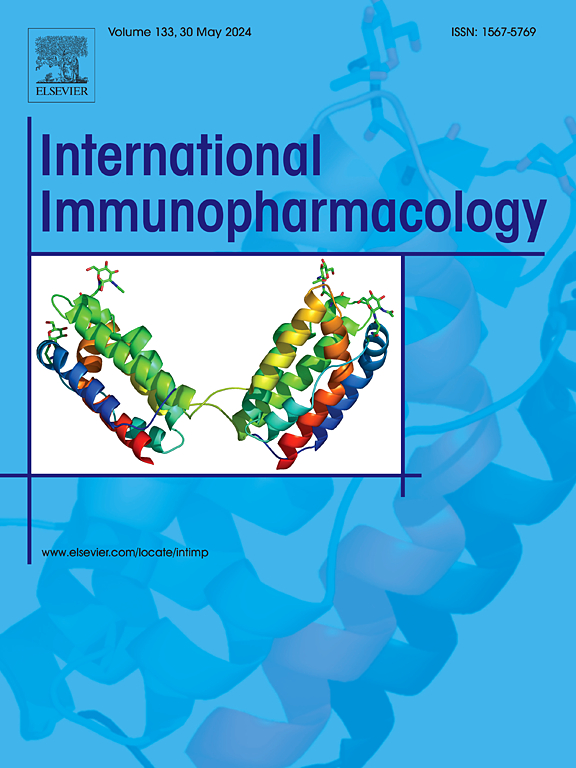多酚的微生物代谢产物 4-羟基苯乙酸可通过抑制 ROS 的产生来抑制破骨细胞的生成。
IF 4.8
2区 医学
Q2 IMMUNOLOGY
引用次数: 0
摘要
细胞内活性氧(ROS)的积累是破骨细胞分化的关键。人们广泛研究了可减少 ROS 生成的植物多酚,以治疗骨质疏松症。然而,这些化合物在小肠中很少被吸收,而是被结肠中的微生物群转化为酚酸。然后,这些大量的低分子量酚酸就能被人体吸收。4-羟基苯乙酸(4-HPA)是这些多酚的重要代谢产物,由人体肠道微生物群生成。然而,人们对其潜在机制还不完全了解。本研究旨在阐明 4-HPA 对破骨细胞生成和治疗骨质疏松症的作用。研究表明,4-HPA 可抑制破骨细胞的分化和功能,并下调破骨细胞特异性基因,包括 NFATc1、Atp6v0d2、MMP9、CTSK、Acp5 和 c-Fos。至于进一步的机制探索,4-HPA通过调节核因子红细胞2相关因子(Nrf2)减少了ROS的积累,随后抑制了核因子卡巴B(NF-κB)和丝裂原活化蛋白激酶(MAPK)通路。为了评估 4-HPA 对绝经后骨质疏松症的影响,我们使用了卵巢切除(OVX)小鼠模型。显微 CT 和组织形态学分析表明,4-HPA 能有效防止骨质流失。令人鼓舞的是,4-HPA 在治疗 OVX 引起的骨质疏松症方面表现出了疗效。总之,我们的研究发现,肠道微生物产生的多酚代谢物 4-HPA 也能抑制破骨细胞的形成并治疗骨质疏松症,这为治疗骨质疏松症提供了新的实验依据和候选药物。本文章由计算机程序翻译,如有差异,请以英文原文为准。
4-Hydroxyphenylacetic Acid, a microbial-derived metabolite of Polyphenols, inhibits osteoclastogenesis by inhibiting ROS production
Intracellular reactive oxygen species (ROS) accumulation is key to osteoclast differentiation. Plant-derived polyphenols that have reduced ROS production have been widely studied for the treatment of osteoporosis. However, these compounds are rarely absorbed in the small intestine and are instead converted to phenolic acids by the microbiota in the colon. These large quantities of low-molecular-weight phenolic acids can then be absorbed by the body. 4-Hydroxyphenylacetic acid (4-HPA) is an important metabolite of these polyphenols that is generated by the human intestinal microbiota. However, its potential mechanism is not fully understood.
In this study, we aimed to elucidate the role of 4-HPA on osteoclastogenesis and treating osteoporosis. Our study showed that 4-HPA inhibited osteoclast differentiation and function and downregulated osteoclast-specific genes, including NFATc1, Atp6v0d2, MMP9, CTSK, Acp5, and c-Fos. As for further mechanism exploration, 4-HPA reduced ROS accumulation by regulating nuclear factor erythroid 2-related factor (Nrf2) and subsequently inhibited the nuclear factor kappa B (NF-κB) and mitogen-activated protein kinase (MAPK) pathways. To evaluate the effect of 4-HPA on postmenopausal osteoporosis, an ovariectomized (OVX) mouse model was used. The Micro-CT and histomorphometry analyses showed that 4-HPA effectively prevents bone loss. Encouragingly, 4-HPA demonstrated efficacy in treating osteoporosis induced by OVX.
In conclusion, our study revealed that 4-HPA, a polyphenol metabolite produced by intestinal microorganisms, also inhibits osteoclast formation and treats osteoporosis, which provides a new experimental basis and candidate drug for the treatment of osteoporosis.
求助全文
通过发布文献求助,成功后即可免费获取论文全文。
去求助
来源期刊
CiteScore
8.40
自引率
3.60%
发文量
935
审稿时长
53 days
期刊介绍:
International Immunopharmacology is the primary vehicle for the publication of original research papers pertinent to the overlapping areas of immunology, pharmacology, cytokine biology, immunotherapy, immunopathology and immunotoxicology. Review articles that encompass these subjects are also welcome.
The subject material appropriate for submission includes:
• Clinical studies employing immunotherapy of any type including the use of: bacterial and chemical agents; thymic hormones, interferon, lymphokines, etc., in transplantation and diseases such as cancer, immunodeficiency, chronic infection and allergic, inflammatory or autoimmune disorders.
• Studies on the mechanisms of action of these agents for specific parameters of immune competence as well as the overall clinical state.
• Pre-clinical animal studies and in vitro studies on mechanisms of action with immunopotentiators, immunomodulators, immunoadjuvants and other pharmacological agents active on cells participating in immune or allergic responses.
• Pharmacological compounds, microbial products and toxicological agents that affect the lymphoid system, and their mechanisms of action.
• Agents that activate genes or modify transcription and translation within the immune response.
• Substances activated, generated, or released through immunologic or related pathways that are pharmacologically active.
• Production, function and regulation of cytokines and their receptors.
• Classical pharmacological studies on the effects of chemokines and bioactive factors released during immunological reactions.

 求助内容:
求助内容: 应助结果提醒方式:
应助结果提醒方式:


